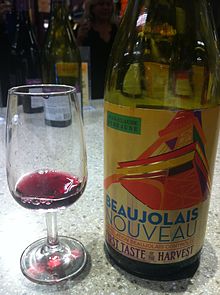Carbonic maceration

Carbonic maceration is a
During carbonic maceration, an
History
The process of carbonic maceration occurs naturally in a partial state without deliberate intervention and has occurred in some form throughout history. If grapes are stored in a closed container, the force of gravity will crush those at the bottom, releasing grape juice. Ambient yeasts present on the grape skins will interact with the sugars in the grape juice to start conventional ethanol fermentation. Carbon dioxide is released as a by-product and, being denser than oxygen, will push out the oxygen through any permeable surface (such as slight gaps between wood planks), creating a mostly anaerobic environment for the uncrushed grape clusters to go through carbonic maceration. Some of the earliest documented studies of the process were conducted by the French scientist Louis Pasteur, who noted in 1872 that grapes contained in an oxygen-rich environment before crushing and fermentation produced wines of different flavors than grapes produced in a carbon dioxide-rich environment. This was because the fermentation process had already started within the individual grape clusters before yeasts were introduced during conventional fermentation.[1]
Wine production
The use of carbonic maceration is closely associated with the production of
Producers in other parts of
The process is almost always used in conjunction with red wine production since some of the flavor compounds produced by volatile phenols tend to form undesirable flavors with white wine grape varieties.[1]
Other techniques
Semi-carbonic maceration is the winemaking technique where grapes are put through a short period of carbonic maceration, followed by conventional yeast fermentations. This is the process used in producing Beaujolais nouveau wines. To an extent, most wines were historically treated to some form of semi or partial carbonic fermentation (as noted in the history section above) with the amount depending on the shape and size of the vessel the grapes were stored in before crushing. The deeper the vessel, the greater the proportion of grapes that could be exposed to an anaerobic environment caused by the release of carbon dioxide from the crushed grapes on the bottom.[3]
An alternative name for carbonic maceration is "whole grape fermentation", which is distinct from the process of "whole bunch fermentation" common in the Burgundy wine production of Pinot noir. With "whole bunch fermentation", whole clusters of grapes (including stems) are fermented before being crushed. This builds a large "cap" of grape skins, with pathways created by the stems, allowing juice to flow more evenly through caps, increasing the levels of skin contact, or maceration.[4]
Coffee production
Carbonic maceration techniques (e.g. semi-carbonic maceration) have recently been adapted to coffee processing. The ripe coffee cherries are placed inside a hermetic stainless steel tank and left to undergo an anaerobic fermentation. This fermentation process brings out intense aromas, with a taste profile akin to red wine and whisky. These coffee beans usually produce a full-body cup. Known varieties processed with semi-carbonic maceration are Red and Yellow Catuai. Details of fermentation techniques have recently appeared in various specialty coffee media.[5]
References
- ^ ISBN 0-19-860990-6
- ^ Valdiguie Archived 2010-06-13 at the Wayback Machine from a University of California, Davis website
- ISBN 0-19-860990-6
- ISBN 0-19-860990-6
- ^ Newton, Tanya "How Does Fermentation Affect Coffee Flavour Development?", Perfect Daily Grind, WWW, 14 July 2017. Retrieved on 2 December 2018.
